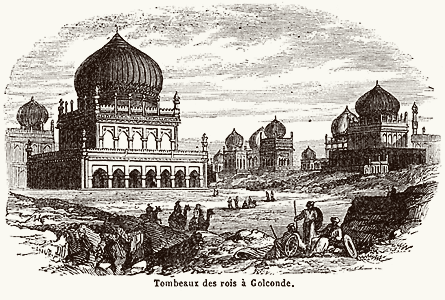
HELAMYS s. (gr. hêlos, marsh; mus, rat). Mamm. genus of rodent, close to the jerboa and of which we know two species, lagotis Cuvieri and lagotis pallipes, both the size and the color of the hare, to which this genus is a substitute in the fauna of …Read more »
Tags: animals, Chile, Ecuador, mammals, Peru, Trousset encyclopedia

JAGANNATH (called Puri by the natives), city located in Bengal (India), on the north-western coast of the bay of Bengal, in the province of Orissa, 44 miles (70 km) south of Cuttack; pop. approximately 30,000. At the end of the main street, which is very broad, rises the famous temple, the holiest sanctuary of Hindoustan, visited by more than one million pilgrims every year. It is enclosed inside a square area, surrounded by high stone walls; each side is 240 yards (220 m) long. On the eastern side is the main gate, from where a broad staircase leads to a terrace 23 feet (7 m) high, enclosed in a second wall and which is 162 yards (148 m) long on each side. The main pagoda rises from this terrace, on a 32.8 square feet (10 m2) base, to a height of 230 feet (70 m) above the ground. Most Hindu divinities have dedicated temples within. The great temple is dedicated to Krishna and derives its name from this divinity: Jagannath (properly Jagannâtha, lord of the world), Siva and Subhadra are the other main objects of worship. Each idol is provided with …Read more »
Tags: buildings and monuments, Hindu, Hindustan, India, temple, Trousset encyclopedia

HALBERD s. (germ. helmbarte, axe with handle). variety of pole weapon, topped with a long, broad and pointed blade, which is crossed by a second, crescent-shaped one: a halberd blow.
– Encycl. The halberd was a pole weapon made in such a way that the man who carried it could both cut and thrust. It was handled with both hands and it could cut off the head of a horse or that of a man, in spite of the resistance …Read more »
Tags: Hastings, infantry, miscellaneous, Norman, Swiss, Trousset encyclopedia, UK, weapon

MERGANSER S. Ornith. type of lamellirostral palmiped, it includes species which have a bill which is thinner and of a more cylindrical shape than that of ducks; with sharp teeth pointed backwards. In winter these birds live on our rivers and destroy a great quantity of fish; in summer, they move to the north of Europe. They nest on the shore, on grass and between stones; the female lays from 10 to 14 whitish eggs. The flesh of the merganser is dry, oily and not much sought-after. The common merganser or large merganser (mergus mergamer) is a little taller than …Read more »
Tags: animals, birds, ducks, ornithology, palmipeds, Trousset encyclopedia

HALICARNASSUS (originally called Zephyria), Ancient city in Caria (Asia Minor), on the Ceramic gulf. Today its site is occupied by the town of Boodroom or Budrun, 75 miles (120 km) S. of Smyrna (pop. approximately 10,000), remarkable only for the ruins of the old city. Halicarnassus was founded by a Trœzan colony and it was one of the six cities which constituted the doric exapole. It was conquered by the Persians under Darius. They let the Greek Lygdamis rule it, with the title of dynast. Artemisia, daughter and successor of Lygdamis, fought with the fleet of Xerxes at Salamis. around 380 BC, the city appears to have belonged to half-independent carian princes, among which the most famous was Mausolus, who rebuilt it and fortified it. He died in 352 and for his tomb, his young wife Artemisia had a monument erected which was so magnificent, that such constructions are still called mausoleums. A little time later, the city returned to Persia. Alexander the Great burned it, a catastrophy …Read more »
Tags: antiquity, archeology, Asia, buildings and monuments, history, tombs, Trousset encyclopedia

FUCHSIA s. (from Fuchs, pr. n.) Bot. Genus of the onagraceae family, it includes about fifty species of shrubs and an infinity of ornamental varieties, sought-after by horticulturists. This genus is entirely American, except for two species found in New Zealand, the majority of the species being indigenous to Mexico and the mountains of Brazil. Cultivated fuchsias can be divided into three sections: fuchsias with short flowers, fuchsias with long flowers and fuchsias with flowers in panicles. Among fuchsias with short flowers we find fuchsia coccinea from Chile, also called fuchsia glabosa by some florists. For many years it was the only species known in the United States. It is remarkable for its axillary and hanging flowers, with scarlet chalice and purple petals. In the long flowers section, the tube of the chalice is longer by 1.57 inches (4 cm) to 2.36 inches (6 cm). Fuchsia fulgens, bright Mexican species, comes …Read more »
Tags: Brazil, flowers, Mexico, onagraceae, plants, Trousset encyclopedia

GOLKONDA, ancient city and fortress in India, part of the Nizam’s possessions, 1O kil. (6.25 miles) N.-W. of Hyderabad. The fortress is used today as a prison and a place where to store the treasure. Approximately 600 m. (656 yards) away from this fortress stand the splendid mausoleums of former kings of Golkonda. Each mausoleum stands at the center of a vast quadrangular platform which can be reached on any side by a granite …Read more »
Tags: antiquity, archeology, Asia, buildings and monuments, history, India, tombs, Trousset encyclopedia









